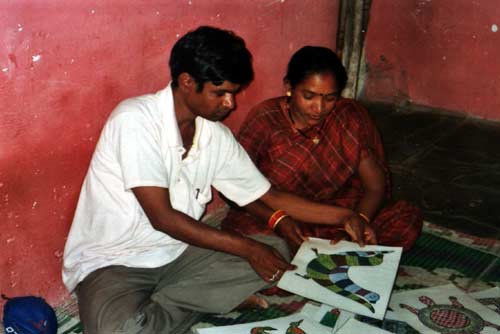Gond Artists
- Anand Singh Shyam
- Bhajju Shyam
- Birbal Singh Uikey
- Choti Tekam
- Dhanaiya Bai
- Dhawat Singh Uikey
- Dilip Shyam
- Durga Bai
- Gariba Singh Tekam
- Hargovind singh Urveti
- Harilal Dhruve
- Indu Bai Marawi
- Japani
- Jyoti Bai Uikey
- Kala Bai
- Kamlesh Kumar Uikey
- Lakhanlal Bharwe
- Manna Singh Vyam
- Mansingh Vyam
- Mayank Kumar Shyam
- Mohan Singh Shyam
- Nankusia Shyam
- Narmada Prasad Tekam
- Nikki Singh Urveti
- Pradip Marawi
KALA BAI – GOND ARTIST of MADHYA PRADESH
Download Interview (Audio) | View Paintings

Kala Bai, the first Gond Pardhan woman to use canvas, brushes and acrylic paint for her artistic expressions, enjoys painting tigers and reindeer, trees and birds. The tigers, in her paintings are especially dear to her, as they remind her of her childhood in Amarkantak, when tigers roamed the nearby forests. As a young girl, she saw tigers in many moods, which she now tries to portray in her paintings.
When Kala Bai was nine, and living in Patangarh, she and the other children used to take their families’ goats and bullocks out to graze by the river. The oldest boy in the group was Jangarh Singh Shyam, step brother of Kala’s mother. Kala Bai recalls fondly how Jangarh once caught a water snake thinking it was a fish, and then had to throw it back into the water amidst much laughter and screaming. The children had great fun, jumping into the river, splashing each other with water while the animals grazed.
It was in Bharat Bhawan that Kala was first given paints and paper to work with. By that time, she was married to Anand Singh Shyam who worked there in the department of Graphics. Kala, an artist refused to paint on paper and had insisted she would create her pictures on the wall instead. She drew a tiger on the wall, and it was greatly appreciated by all who saw it.
When the state of Chattisgarh was carved out of Madhya Pradesh, Kala Bai and Anand Singh Shyam drew the new map of Madhya Pradesh. The map was released by the then President of India Dr A. P. J. Abdul Kalam. Dr Kalam asked them many questions about their culture and way of life. Later he bought one of their paintings of the Karma dance.
Another memorable incident was when Leslie, a film animator from Scotland involved Kala Bai and other artists to illustrate a Gond folktale, which was later turned into an animated film by Tara Douglas. The film won an award in the Tallest Story Competition in Scotland.
Kala Bai used to take her son, Sambhav and daughter, Anita to painting camps and workshops, all over India. Now, though both children are in school, appearing for their board exams (X and XII), they continue their parents’ tradition and have taken up painting in their spare time.
Gond Artists
- Prasad Kusram
- Premi Bai
- Pyarelal Vyam
- Radha Tekam
- Raj Kumar Shyam
- Rajan Singh Uikey
- Rajan Prasad Kusram
- Rajni Vyam
- Rajendra Singh Shyam
- Rambai Tekam
- Ram Narain Marawi
- Ram Singh Urveti
- Ramesh Tekam
- Ravi Tekam
- Roshni Vyam
- Santosh Kumar Vyam
- Santoshi Tekam
- Saroj Venkat Shyam
- Shanti Bai
- Subhash Vyam
- Sukhanandi Vyam
- Suresh Dhrube
- Venkat Shyam
- Vinod Kumar Tekam




